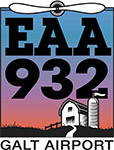If you have flown in the chilly midwest recently you may have noticed a significant improvement in the takeoff performance of your aircraft. Increased performance is a good thing, but it can take inexperienced pilots by surprise when the airplane leaps off the runway in less than 400 feet and reaches traffic pattern altitude with alarming efficiency!
Private pilot training focusses heavily on less dense air at higher altitudes and in hotter temperatures and the negative affects on aircraft performance. For those of you who need a reminder; lower density air reduces lift because there is less force on the airfoils, reduces thrust because the propeller is not as efficient, and reduces power output because the engine takes in less air.
The opposite effects apply in cooler, more dense air but little attention is paid to how colder than standard temperatures might influence the capabilities of the aircraft in the winter months.
Most Aircraft Flight Manual (AFM)/Pilot’s Operating Handbooks (POH) offer a very limited takeoff performance chart which doesn’t really prepare the pilot for the realities of alternative situations at any time of year. The 1975 Cessna 172 Take-Off Performance chart uses four (pressure) altitude and temperature combinations; sea level at 59°F, 2,500 feet at 50°F, and 5,000 feet at 41°F, and 7,500 feet at 32°F. The 1976 version of the C-172 Skyhawk POH, on the other hand, has a table with pressure altitudes from sea level to 8,000 feet and five temperature options; 0°C, 10°C, 20°C, 30°C, and 40°C. Both offer three gross weight options.
Most days the weather conditions don’t fit into any one of these categories but we must do our best to pick the closest (more conservative) option. For example, this morning the Rockford (KRFD) METAR indicated -19°C with a field elevation of 742 feet and an altimeter setting of 30.27 resulting in a pressure altitude of 392 MSL. Taking into account the temperature and humidity, ForeFlight calculated a density altitude of -3,768. The POH doesn’t have a data point that is even close to this combination. The shortest ground roll distance in the C-172 POH takeoff performance table is 505 feet at sea level and 0°C at a gross weight of 1900 pounds with no wind.
Don’t get me wrong, better performance is preferable but it does change a few things that might come as a surprise to students and newer pilots. In addition to a shockingly shorter takeoff roll, climb performance will also be greatly improved in colder temps. POH rate of climb tables are similarly light on data options with the 1975 C-172 POH beginning at sea level and 15°C with three weight options and the 1976 version starting at -20°C at maximum gross weight only. The best rate of climb the POH indicates at sea level and -20°C is 755 feet per minute, but in my experience you will see considerably better than that on your vertical speed indicator (VSI).
So how does all this affect aircraft in the traffic pattern? The first factor is that when your takeoff ground roll is shorter, your climb out begins sooner. Combined with a much steeper rate of climb, you will reach the point of turning crosswind (300 feet below traffic pattern altitude) in a shorter distance than usual. When you make your turn to downwind you might find yourself already pretty close to the midfield downwind position. Because you covered less distance in the upwind leg, there will be a shorter distance than you might normally expect in the downwind leg.
The pattern might feel like it is going much faster than normal and you may feel rushed and lacking enough time to level off, slow down, make the appropriate radio calls and complete the appropriate checklist items before you find yourself abeam the numbers.
This can lead to starting your descent later than usual, extending your downwind and altering your glide path. As I’m sure your CFI has told you before, a good traffic pattern sets you up for a good landing. If you haven’t reached your desired configuration abeam the numbers you are less likely to be stabilized on final and that reduces your chances of a good landing.
If you need more time in the traffic pattern to prepare for landing I would suggest extending your upwind leg before you turn crosswind. This provides more time on the downwind leg to get organized before you begin your descent. In time, and with practice, you will become quicker and more efficient at traffic pattern procedures, but it always helps to know what to expect and to be prepared. Pilots should consider aircraft performance on every flight and have an understanding of how it will impact you even if you plan to go no further than the traffic pattern.
Beth Rehm, CFI

